If you are starting out on your first landscaping project, then you should know that it’s not only your trees and container gardens that deserve attention. So do your shrubs! These plants add a different aspect and dimension to your garden that may very well be the extra element that your garden needs. Indeed, these plants will make your guests go “wow, that’s beautiful” whenever they visit. In this article, I’ll introduce you to 11 low growing perennials.
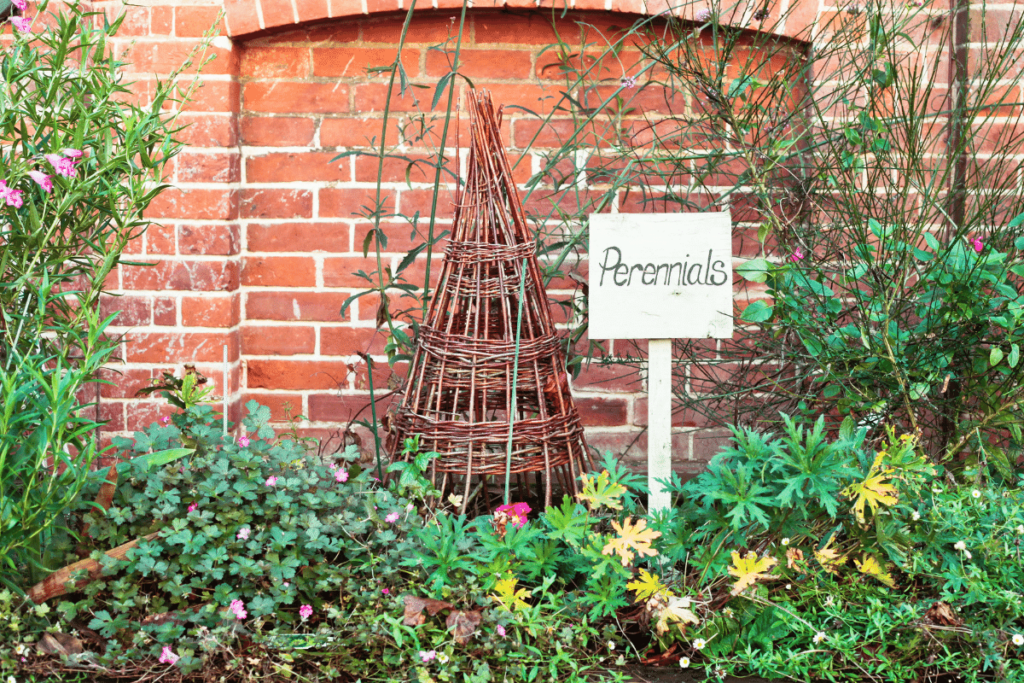
Why plant low growing perennials?
Perennial plants that are low growing and bloom with short flowers are ideal for not only accentuating the borders of your garden. It also elevates the aesthetic of your paths and walkways. As an added bonus, they can also serve to add texture around and between your taller plants. They also create a more rounded scenery rather than leaving lackluster gaps in your landscape.
So to help you with your quest to elevate your garden game up a notch, we have compiled 20 low-growing perennial plants below. These plants will surely get your creative gears turning.
1. Moss Phlox
Moss Phlox, scientifically named Phlox subulata, is one of the most adorable flowers on this list. It is also noteworthy due to the varieties it has. Their cute flowers, which are star-shaped, come in a wide array of colors such as blue, purple, white, pink flowers, and multicolor varieties.

When the flowers bloom, they shower the ground with an extravagant display of color. They grow three to six inches in height and blanket the ground with green fronds, resembling moss in appearance (hence its name). The plant will continue adding texture and depth to your landscape even outside the blooming season.
Some cultivars to look out for are the White Delight or the Snowflake if you want a pure white carpet of flowers. If pink suits your alley more, look for Candy Stripe, Scarlet Flame, or Purple Beauty. These plants are hardy from zones three to eight. This is different from the garden phlox, Phlox paniculata.
RELATED: No Shrinking Violets: 18 Different Types Of Violet Plants
2. Eastern Pasque Flower
The eastern pasque flower, scientifically called Pulsatilla patens, shines best during the spring, making it an early bloomer as compared to others on this list. They bloom with solitary blue, purple, or white flowers that resemble bells. They are also attractive to pollinators such as butterflies and bees and welcome the plant’s bloom as a food source after the winter.
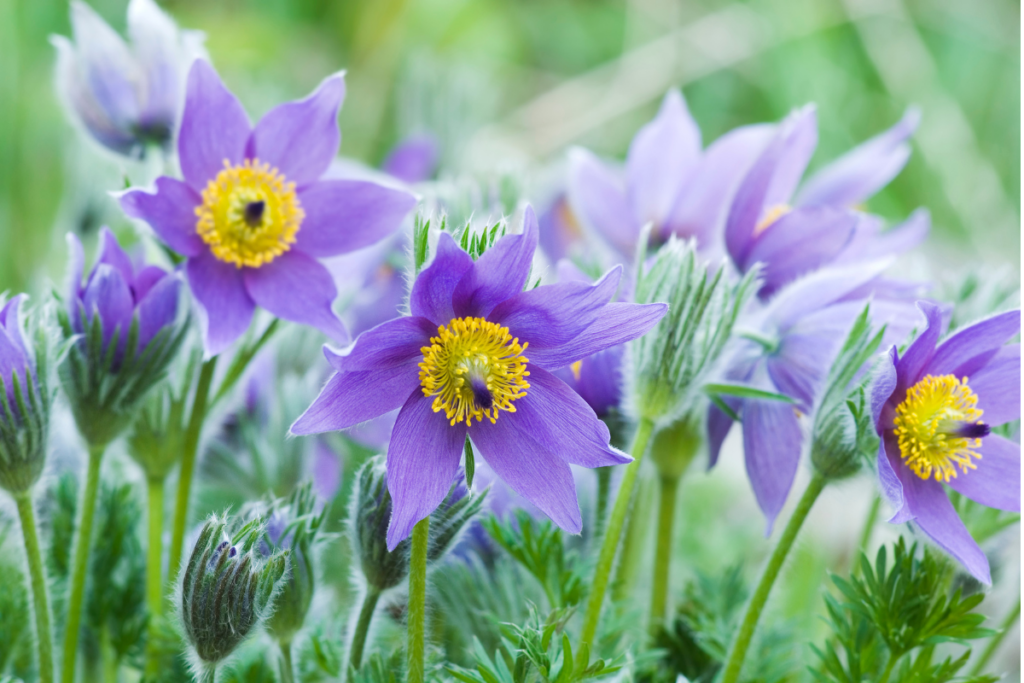
On average, they grow anywhere from three to ten inches tall, with the tallest growing 12 inches in height. The elegant and delicate petals are sharply contrasted by their strikingly yellow stamen in the center and are one of the best delights come springtime. The flowers bloom in one short greenish stem; however, they come out in groups to show a spectacular display of colors. They are hardy from zones four to seven.
3. Bearberry
Do you own a spot in your garden where plants find it troublesome to grow due to improper soil or excessive shade? Then you’re in luck as the bearberry, scientifically named Arctostaphylos uvaursi, thrives well in these conditions. This low-lying evergreen plant thrives in such places where most plants don’t grow.
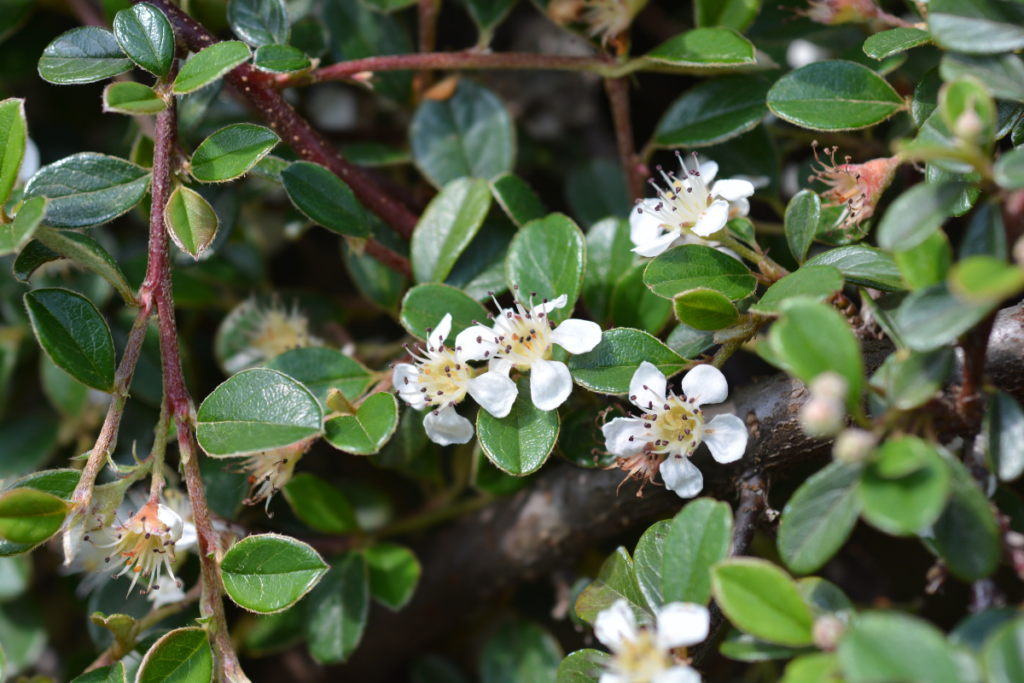
This is a short plant, but it is more than made up for with its vivid green and almost glossy leaves that attach themselves to red stems. It is sure to stand out in any garden. During spring, cute little pink or white flowers that are bell-shaped dangle from their stems, giving them a little fairy look. From the flowers spring forth tiny, red berries that are edible, which is a crucial food provision for birds and mammals.
During the winter, their fronds turn to this rich maroon-purple color, giving your landscape a whole year of intrigue. Aside from the ground cover, they can also serve as decors sprawling over rocks or as a border shrub for your garden. They are hardy from zones two to six.
4. Pussytoes (Antennaria plantaginifolia)
This is a perfect plant for beginners since it is low-maintenance while still being able to produce splendid, deep green spade-shaped leaves. Their foliage averages around 6-12 inches tall and can serve as the main focal attraction of your garden.

Their flowers are dainty, white, and fluffy, giving them an ethereal cloud-like aesthetic that gives your garden a dreamy ambiance. Their inflorescences do not stand out as much, but pollinators like butterflies and birds will appreciate them.
If you’re looking for simple, low-maintenance, and a lovely groundcover, you won’t go wrong with pussytoes. They are also tolerant to drought, grown in poorer soils, and shaded locations, and hardly encounter many pests or diseases. These plants are hardy from zones 3-8.
5. Rose Vervain
Also known as “verbena”, the Rose Vervain, with the scientific name Glandularia canadensis, is a low-lying native perennial that drapes over the ground and gives bloom to adorable bright, bluish-purple flowers. Their blooms are flat clusters of five-petaled flowers atop their leaves.
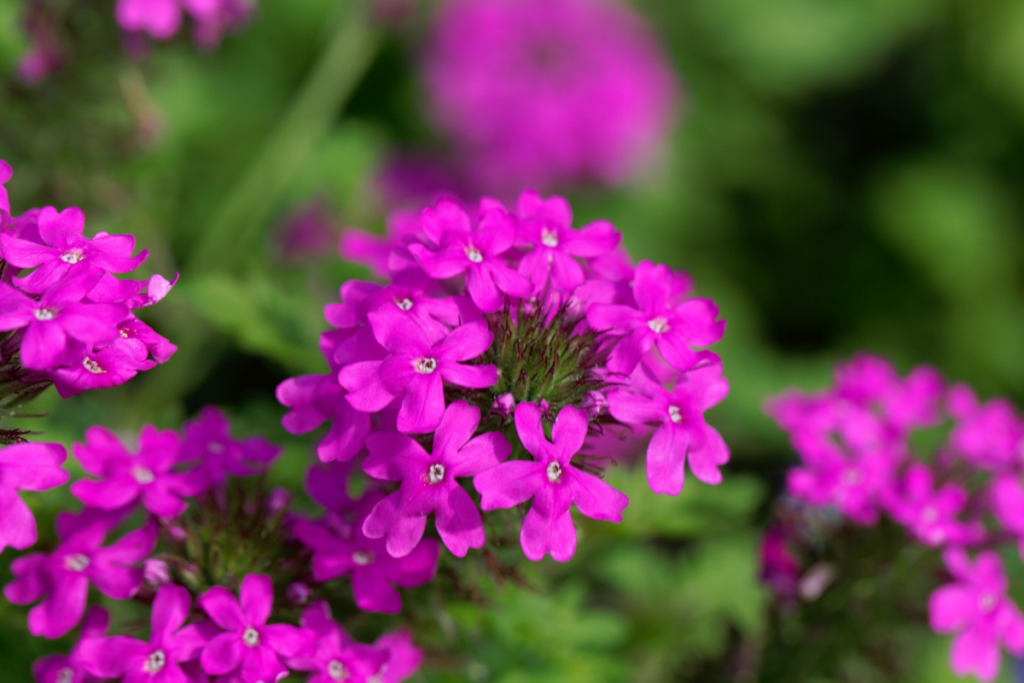
When they bloom, they bring on a dazzling show of colors that is sure to attract pollinators such as bees and butterflies. Their foliage serves as a beautiful deep green background that complements its lustrous flowers.
Verbena’s flowers grow as little as 6 inches to as tall as 18 inches. Try to group them along with your taller plants or along a path or border when planting it. They also thrive in containers or hanging baskets. They are hardy from zones to 5-9.
RELATED: Laid Up In Lavender: 21 Different Types Of Lavender
6. Wallflower (Erysimum)
Wallflowers are not just good groundcovers, but they also provide compact, scented blooms that last from the middle of spring to the middle of summer, especially if deadheaded. They are very easy to grow and versatile plants as they can be used as edging plants, borders and garden beds, container gardens, and rock walls as cascades.

This vigorous perennial can reach up to 12 – 16 inches in height with a spread of up to 10-14 inches. They thrive best in sunny locations and grow healthily in well-drained, alkaline soils. They are also drought-tolerant plants.
7. Stonecrop
Many species, hybrids, and cultivars of Stonecrop come from the genus Sedum, so much so that it is tricky where to begin. Depending on species or cultivar, these plants are shorter with variability in height, but most will fall between the 6-10 inch heights.
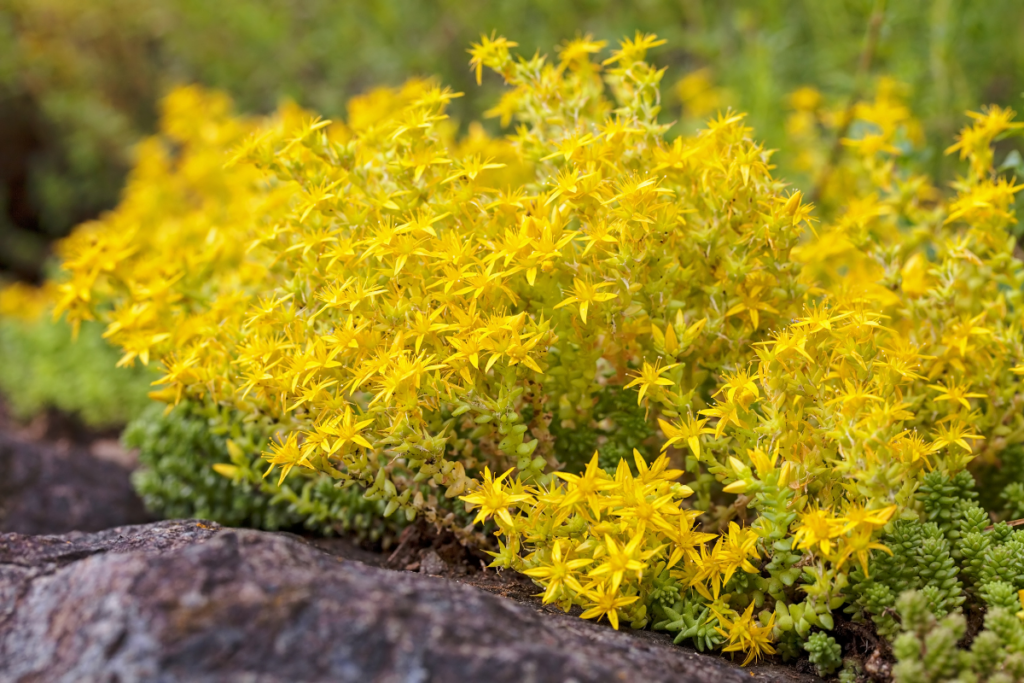
The plant presents with alluring luscious leaves and blooms with petite, 5-petaled rose-like flowers. These plants hug the ground, forming a tapestry of green or blue-green leaves. When they bloom, they explode with bright yellow flowers, carpeting the ground with a brilliant chroma.
They serve as wonderful plants for ground cover, edges, and rock gardens. They also thrive well in containers and hanging gardens.
8. Periwinkle (Vinca sp.)
Another excellent low-growing perennial is the Periwinkle. Its dark green leaves provide excellent ground cover to bare garden areas. It is often seen on creek banks or mountain hillsides in the wild. In USDA zones 4 – 8, periwinkles are used as spreading shrubs. They are often called creeping myrtle or creeping vinca.
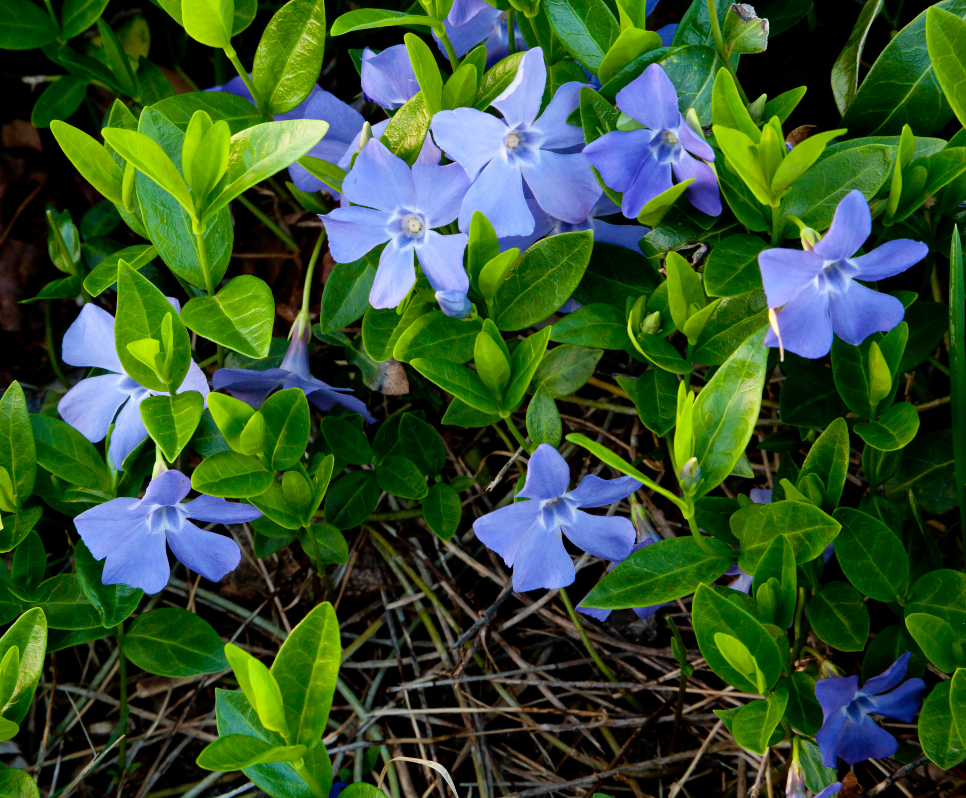
The leaves of the Periwinkle are phlox-like, Periwinkle in color (hence the name) and tubular, growing a little over 6 inches in height. The plant is tolerable under full sun, but it can also tolerate some partial shade as well.
Currently, there are more than 30 varieties of Periwinkle that exist. Some have variegation in their foliage, and some have other flower colors.
9. Perennial Pinks
Commonly known by their Latin nomenclature, Dianthus, or the perennial pinks, are low-growing. They do not demand much attention when it comes to their care. These plants are sure to fit any of your landscaping ideas with a vast array of cultivars and species to pick from. Colors range from purple, pink, and red to even white and black. Some varieties will have multi colors that have funky color contrasts.
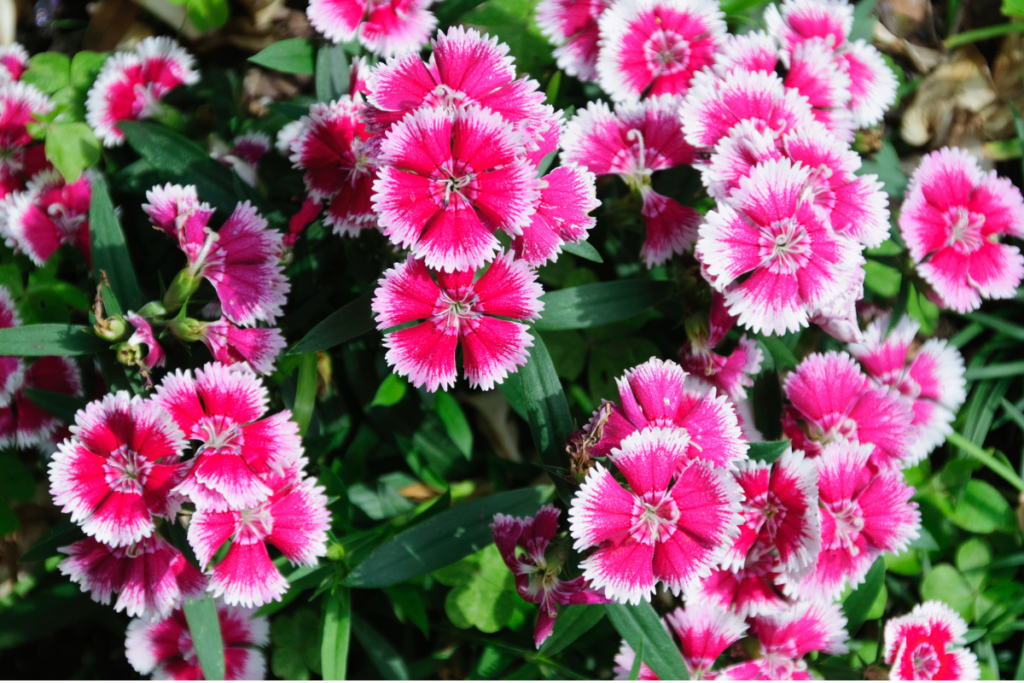
Their fronds are understated, giving them a grass-like feel, and they let their brilliant flowers take center stage. They grow between six and twelve inches tall, and their flowers have a sweet perfume aroma that depends on the variety. They are hardy to zones 4-8.
10. Deadnettle (Lamium)
Lamium is a member of the mint family. They are vigorous trailing or clumping perennials with ovate leaves with white or silver markings. Like other mint family members, deadnettles have quadrangular stems and alternating leaf arrangements. Tubular flowers on spikes add to the aesthetic beauty of the plant. They are tough plants with a wide variety of colors.

Dead nettles can grow up to 24-inches in height and can spread indefinitely without maintenance. The trailing stems grow their own roots whenever they are in contact with the ground. Hence, the prolific growing habit of these plants. Depending on the dead nettle variety, the leaves can be variegated or unvariegated and can grow up to 3 inches in length.
RELATED: As Fresh As A Rose: 20 Different Types Of Rose Of Sharon Flowers
11. Foamflower
The Foamflower plants, with the scientific name Tiarella sp., give bloom to flowers that look like wispy and frothy flowers, hence earning them their nickname. Despite their alluring flowers, it is their foliage that sometimes draws attention. Their leaves can be heart, oak, or shaped like stars, depending on the species. They aren’t green as often, and their leaves are streaked with wine-colored or deep black markings.
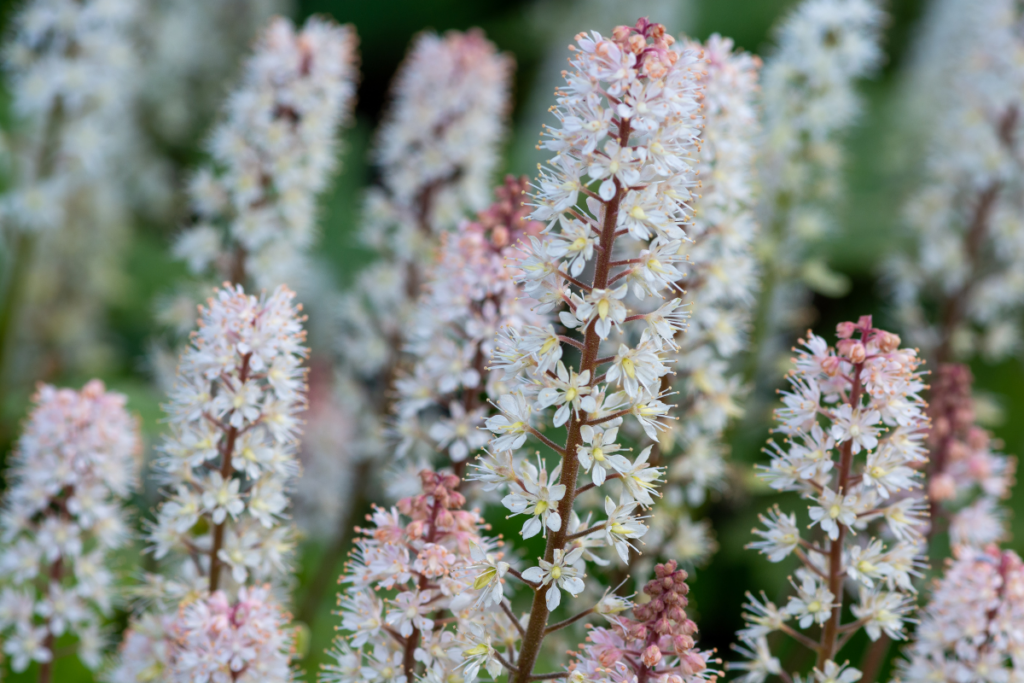
Their height usually doesn’t exceed 12 inches. Their flowers bloom in early spring, above on stems that reach far from its foliage. Their exceptional fronds remain in vibrant color all throughout the year, sometimes deepening in color during the colder months. They grow well in shaded locations. They are hardy from zones four to nine.
12. Coneflowers
Coneflowers from the genus Echinacea have been cultivated since the 1700s. These plants have been used as medicinal plants by the American natives for wound treatment and combat infections. Coneflowers are great prairie plants, having showy, large flowers. Traditionally, coneflowers are purple; however, a wide variety of colors and shapes are now available.

Coneflowers can grow up to 22-32 inches in height, with a spread of 28 inches. They thrive best in full sun, average humidity, and well-draining, moist soil. They tolerate harsh conditions such as drought, humidity, and heat. Coneflowers are excellent for beds and garden borders, cottage gardens, wildflower gardens, and prairies and meadows.
13. Dusty Miller (Jacobea maritima)
These plants are also known for their foliage rather than their flowers. Dusty Miller leaves branches out, silver, with a slight fuzziness to them. Their cute leaves have a texture that resembles the sheep’s wool and deer antlers.
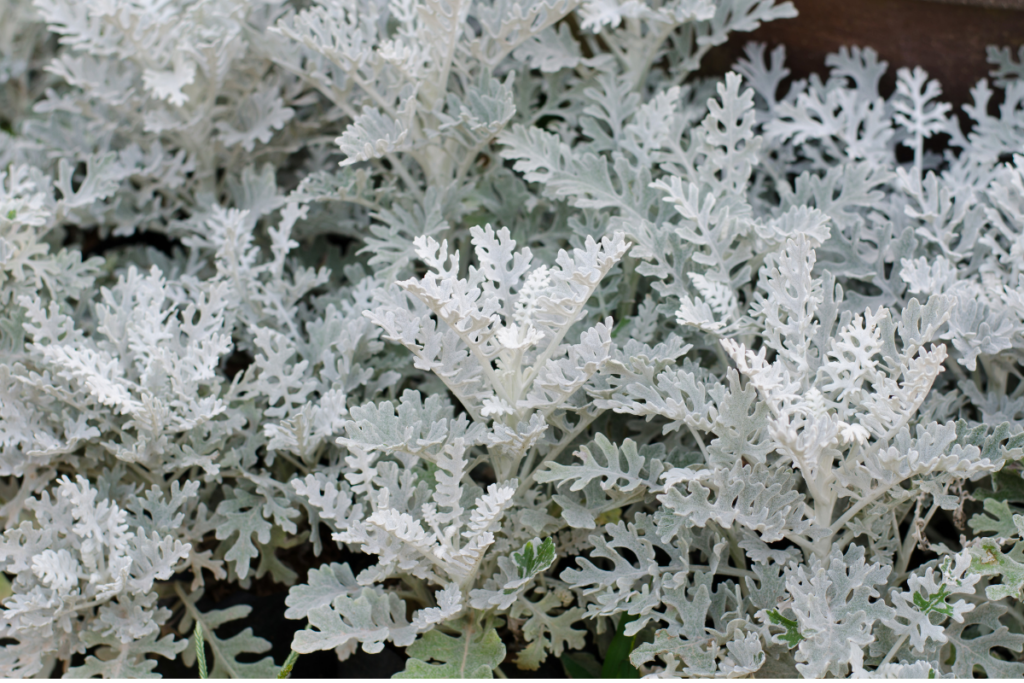
Their leaves are so remarkable that most gardeners cut off the white and yellow flowers because they distract the viewer from the mesmerizing foliage. They add a fluffy and muted aesthetic to the space they occupy, which is perfect for serving as a balance and contrast to your landscape if they contain more plants that love to put on a display of colors. They are hardy to zones 8-11.
14. Sun Rose
Another vigorous, low-lying shrub is the sun rose, or the rock rose. From late spring to the middle of summer, sun roses grow so profusely that they resemble a gorgeous flower carpet on the ground. They have abundant, single, showy bright orange flowers with yellow stamens at the center. The flowers are the main pieces of attraction for this particular plant.
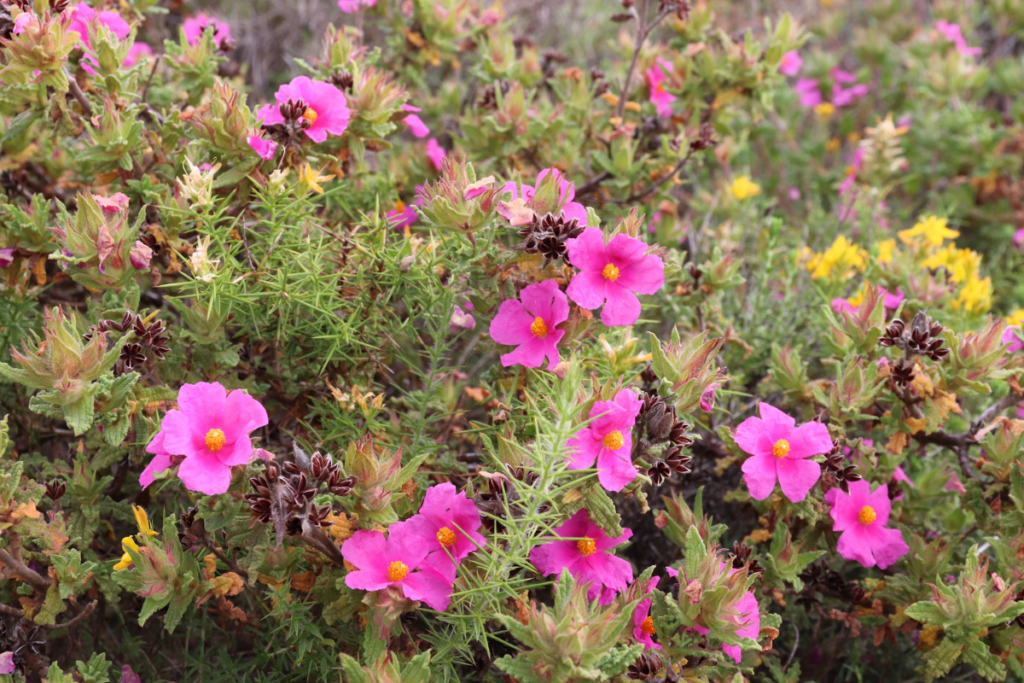
The leaves, dark green with a silver hue, are also compelling. The ground-hugging plant habit makes this plant a good groundcover, especially in sunny locations. They are also drought-tolerant and resilient to high temperatures; thus, they are perfect plants for your bare spaces.
Sun Roses grow up to six to eight inches tall and 18-24 inches wide. They thrive best in full sun, in well-draining soils. Although they are used as an edging plant, border fronts, and ground covers, they are also often put on a stone wall for a mesmerizing cascading effect.
15. Wooly Yarrow
Most varieties of Yarrow grow pretty tall but not Woolly Yarrow, with a scientific name, Achillea tomentosa. They form dense groups of fronds that grow 6-12 inches tall, olive green in color and feather-like in shape, giving them a soft and fuzzy appearance. In the summer, they bloom forth groups of discoid yellow flowers, which stay on top of the foliage for a long time.
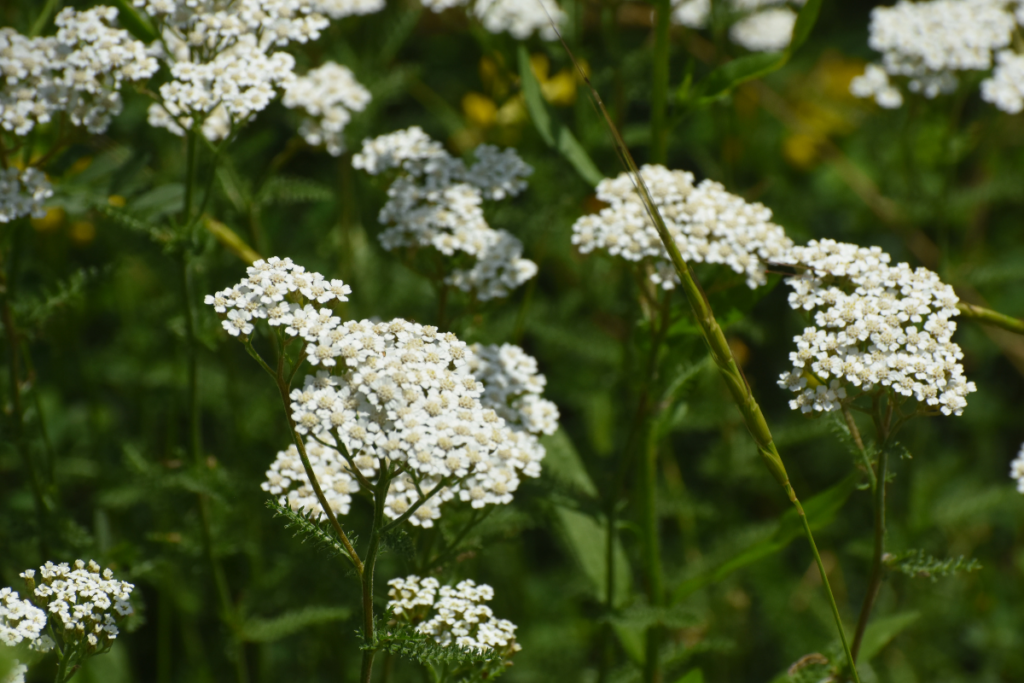
Woolly Yarrows carpet the ground and create a soft texture that is perfect for planting in rock gardens, ground cover, and even containers. Not only are Woolly Yarrows hardy, but they are also drought-tolerant. This perennial flower demands little care and attention for you to grow them. They are hardy from zones 3-7.
16. Coreopsis (Tickseeds)
Coreopsis are common garden plants because they are gardeners’ favorites, thanks to their showy, bright flowers and tolerance to most garden soil types. Coreopsis are low-maintenance plants with a high tolerance to drought and long blooming season. Currently, there are over 100 species and countless hybrids to choose from, depending on your preference.
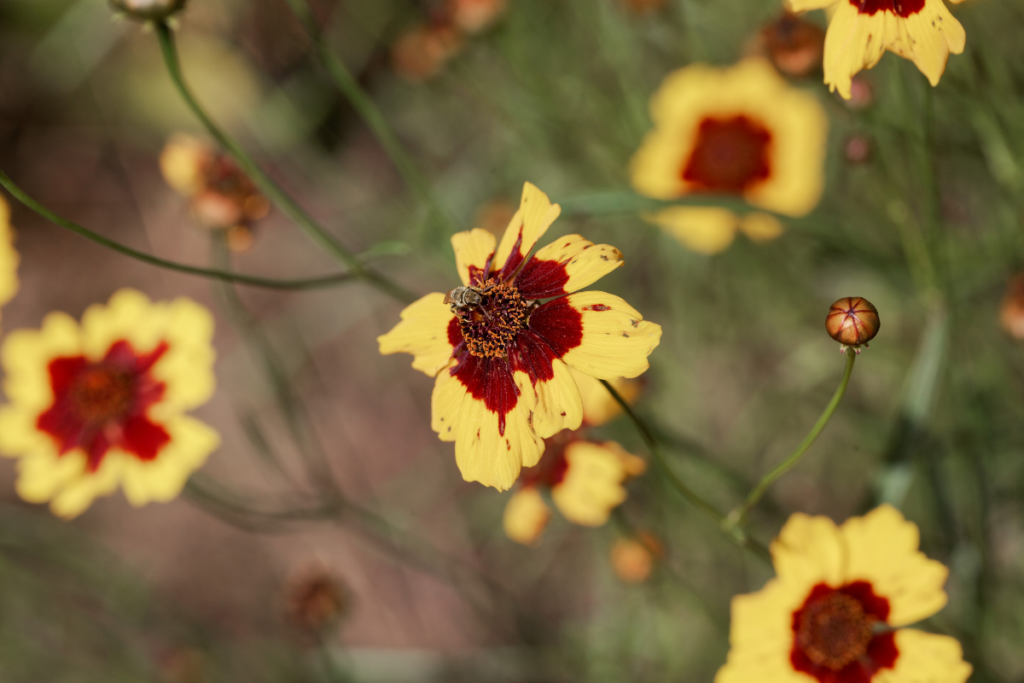
These spring bloomers grow best in zones 3 to 9 and bloom continuously until early fall. They make good cut flowers too. Depending on the conditions, they can grow up to 22 inches or up to two feet tall and 24 inches wide. They are often used in borders and beds, container gardening, and cottage gardens.
RELATED: The Hosta With the Mosta: 9 Different Types Of Hostas
17. Barrenwort (Epimedium gandiflorum)
These plants are sometimes referred to as “fairy wings” for a good reason. It is not their size that makes them adorable but somewhat their shape. They earn their nickname from the flowers that dangle on wire-like stems and petals that bloom like the shape of a fairy’s wings.
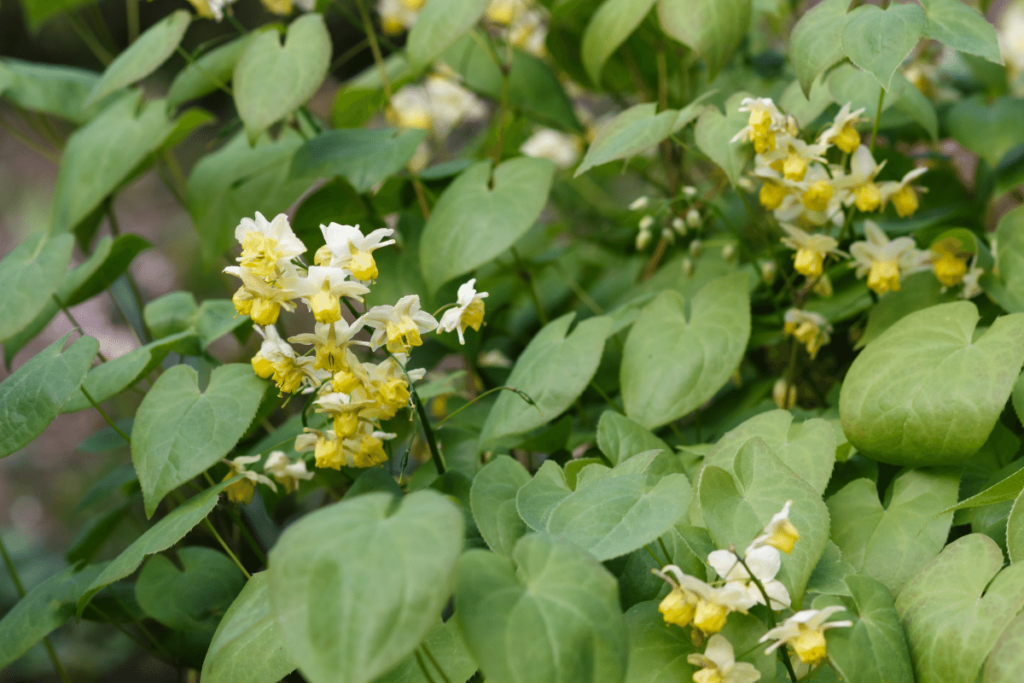
Their flowers do not last as long, which is made up for their foliage that is just as intriguing as their flowers. They come shaped like hearts and rich green or maroon colors, depending on the variety. These plants grow eight to twelve inches high and appreciate partial shade. These plants are drought-tolerant and are hardy from zones four to eight.
18. Mountain Sandwort (Arenaria montana)
Mountain sandworts are spectacular low-lying perennials that grow only up to 6 inches in height and have a spread of 12 inches. The leaves of this plant are small, glossy, and elliptic; however, this is fully covered by its large, white flowers in late spring up until the early summer. They are used in edging paths and rock gardens.
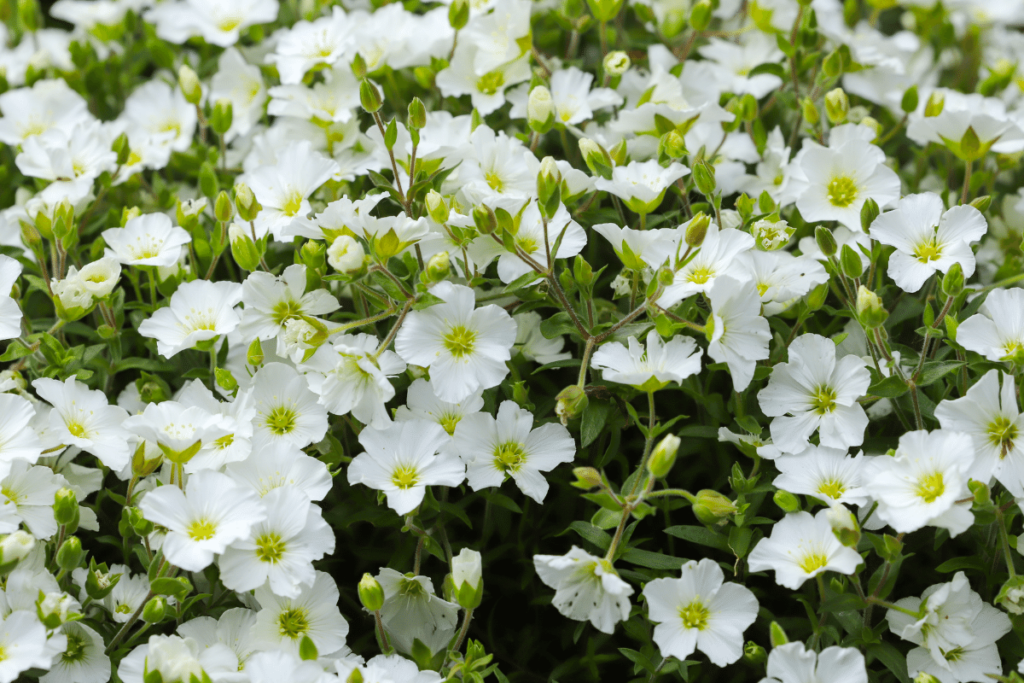
Mountain sandworts thrive best in partial shade or full sun. Well-draining soils are suitable for these plants but can also thrive in sandy soils. They need a lot of moisture during dry periods; thus, regular watering and misting must be done.
19. Alyssums (Lobularia maritima)
Alyssums or Sweet Alyssums is a dashing, dainty plant that could make any garden space fabulous. This plant is low maintenance and has a high tolerance to drought. It has scented blossoms that profusely grow, covering your grounds and borders with a carpet of little flowers. When put in containers or hanging baskets, it beautifully cascades.
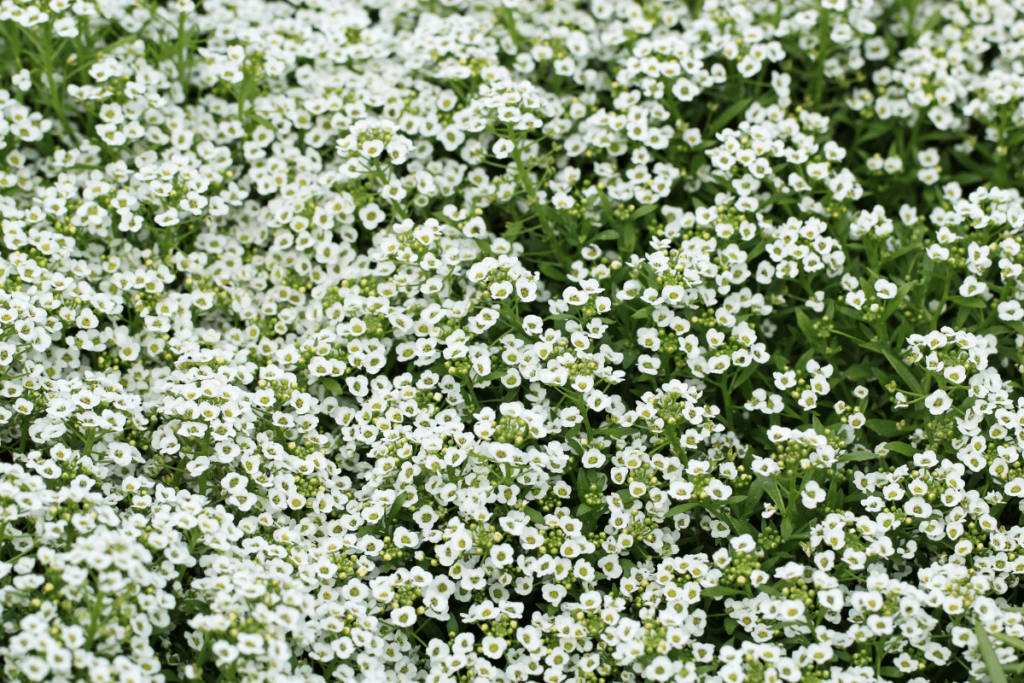
Sweet Alyssums are old-time favorites, with blooms lasting long from spring to winter. What they lack in size, they incredibly make up with the scent. They come in many colors, such as purple, white, apricot, and pink. It can grow up to 12 inches in height and spread about 10-18 inches.
These plants thrive best under full sun, with well-draining soils and average humidity. You can best use it as a groundcover in paving your gardens’ cracks and edges. The species is native to the Southern part of Europe. The Mediterranean native may be invasive in other habitats.
20. Carpet Bugles (Ajuga reptans)
Carpet bugles, scientifically known as Ajuga reptans, are valuable spreaders that make any groundcover lively with colors. It is a fast mat-forming plant that best thrives in shaded locations where ornamental grass could not grow. The flowers come in many colors, such as purples, whites, and pinks, arranged in whorls on spikes.
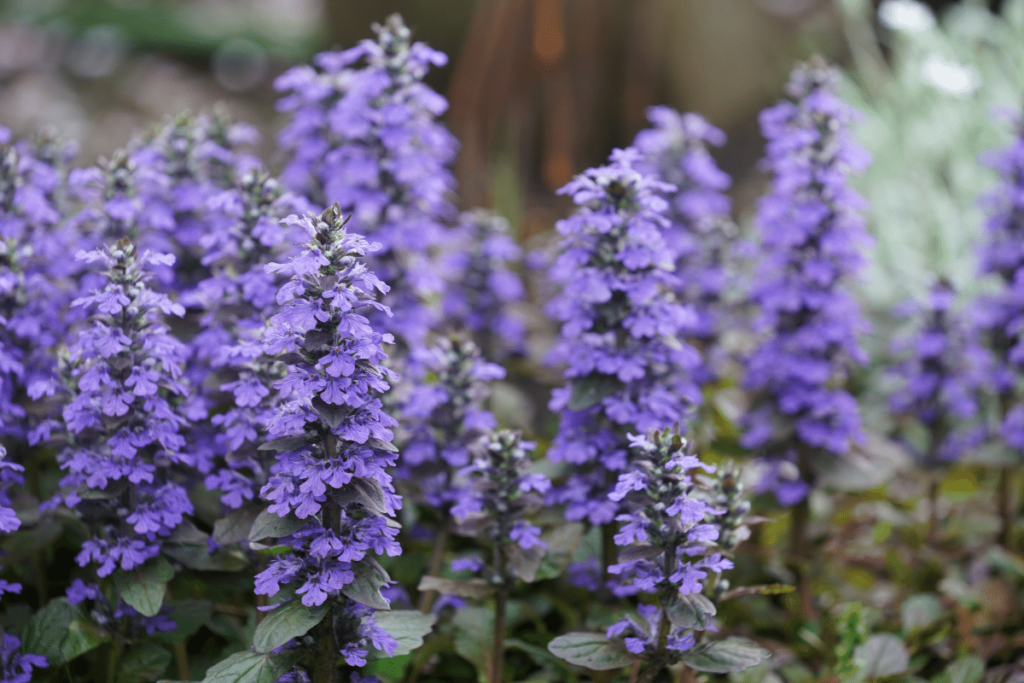
Although the inflorescence is remarkable, gardeners love the evergreen foliage of Carpet Bugles more. They grow up to four to six inches tall and spread about 18 inches wide. They love partial shade to full shade, and thrive in well-draining soils that are moist and rich with organic matters.
Hopefully, this list has given you plenty of ideas for your next landscaping project. Adding even one of these plants gives your garden a more well-rounded and balanced character and body. Low-growing perennials definitely add layers of color, texture, intrigue, and charm that will amaze your next visitors. Not only that, but they fit in various situations from pavements to walls and even containers and hanging baskets. Now go out there, stretch your creative muscles, and incorporate even one of them in your garden for a more engaging landscape scenery.
FAQS
- What plants keep weeds away?
There are a lot of plants that will help you keep weeds at bay. Plants like Coral Bells and Hostas can be planted around shrubs and trees to act as weed controllers.
- What kills weeds but not flowers?
It is very easy to sabotage your own garden. To avoid doing this, it is suggested that you create organic weed killers at home using common household ingredients such as lemon, vinegar, and salt. Just mix them using water and spray your soil regularly.
- Can you plant hostas and lavender together?
Though Hostas and Lavenders look great together and complement each other, the pairing sadly is a no-go. Hostas and Lavenders have different light requirements. Hostas thrive best under shade or dappled sunlight. On the other hand, lavenders love full sun.
- What grows under a messy tree?
Shade plants best thrive under trees. Examples of which are hostas and fern. Semi-shade varieties can also be planted along the perimeter of the branches like Coral Bells and Lily of the Valley. Full-sun plants could not thrive in this light condition.
- Is it better to spray weeds or pull them?
Depending on the area, hand-weeding is better if the weeds are only a handful. However, spraying is better if the weed infestation is already extreme.
Editor’s Recommendations
Dahlias: The Number 1 Care, Propagation, and Watering Guide For Your Garden Flowers
Fall In Love With 19 Stunning Types Of Alocasia
Types of Naked Ladies Flowers – Three Species Under the Same Name







